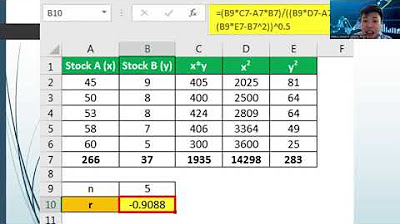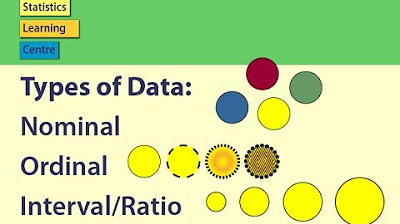BAB VI METODE SUKSESIF INTERVAL|MSI|STATISTIKA TERAPAN|
Summary
TLDRIn this tutorial, the speaker explains how to apply the Successive Interval Method (MSI) using Microsoft Excel to convert ordinal survey data into interval data. The example involves a shoe business in Bandung, where a customer satisfaction survey was conducted. The video outlines the steps, including calculating proportions, cumulative proportions, Z-values, density functions, scale values, and transformed intervals using Excel formulas. The process allows for an efficient transformation of ordinal data into interval data, essential for statistical analysis and further interpretation of the survey results.
Takeaways
- 😀 The script introduces the topic of applied statistics, specifically focusing on the Successive Interval Method (MSI) using Microsoft Excel.
- 😀 The example used is a shoe business in Bandung that conducts a customer satisfaction survey with 35 respondents.
- 😀 The survey data includes ordinal scales (Very Satisfied, Satisfied, Neutral, Dissatisfied, Very Dissatisfied) and frequencies for each category.
- 😀 The first step is to input the data into an Excel spreadsheet, creating a table with ordinal scales and corresponding frequencies.
- 😀 Next, the script guides viewers to calculate proportions by dividing each category's frequency by the total number of respondents.
- 😀 The cumulative proportion for each category is calculated by adding the previous proportion to the current one.
- 😀 Z-values are calculated using the Excel IF function, considering cases where cumulative proportions equal 0 or 1.
- 😀 The density function for each Z-value is computed using a Z-distribution formula in Excel.
- 😀 Scale values are calculated by finding the difference between consecutive density values, divided by the difference in cumulative proportions.
- 😀 The final transformation step involves adding a constant to each scale value to obtain the interval values.
- 😀 The MSI method transforms ordinal data into interval data, allowing for more precise statistical analysis such as averages or regressions.
Q & A
What is the Successive Interval Method (MSI)?
-The Successive Interval Method (MSI) is a statistical technique used to convert ordinal data into interval data. This method is useful when you have ordinal scales (like satisfaction levels) and need to perform interval-level statistical analysis.
Why is MSI important in statistical analysis?
-MSI is important because it allows analysts to transform ordinal data, which has a rank order but lacks equal intervals, into interval data that has consistent, measurable differences between values. This enables more advanced statistical methods to be applied.
What software is used to demonstrate the MSI method in this tutorial?
-The tutorial demonstrates the MSI method using Microsoft Excel. Excel is used to perform calculations and transformations needed to apply MSI to the given dataset.
What is the first step in performing MSI in Excel?
-The first step is to input the data into Excel, including the ordinal scales (like 'Very Satisfied' and 'Dissatisfied') and their respective frequencies. This forms the basis for all subsequent calculations.
How do you calculate proportions in the MSI method using Excel?
-To calculate proportions, divide the frequency of each category by the total number of respondents. In Excel, you can use the formula `=frequency/total` where the total is the sum of all frequencies.
What is a cumulative proportion and how is it calculated in Excel?
-A cumulative proportion is the running total of proportions. In Excel, you can calculate it by adding each proportion to the previous one, starting from the top of the list. For example, the second cumulative proportion would be the first plus the second.
What is the purpose of calculating Z-scores in MSI?
-The Z-score represents the number of standard deviations a data point is from the mean of the distribution. In MSI, it helps standardize the cumulative proportions to a normal distribution, allowing for easier transformation of ordinal data into interval data.
How is the density function used in MSI?
-The density function is used to calculate the probability density for each Z-score. In Excel, the `NORMDIST` function is applied to each Z-score to obtain the corresponding density value, which is part of the transformation process.
What formula is used to calculate the scale values in MSI?
-The scale value is calculated by subtracting the density of the first interval from the density of the second, divided by the difference in the cumulative proportions. The formula in Excel looks like `=(density2 - density1) / (cumulativeProportion2 - cumulativeProportion1)`.
How do you calculate the transformed values in MSI?
-To calculate the transformed values, find the smallest scale value using Excel's `MIN` function, then apply the formula `1 + ABS(smallest scale value)`. The final transformed values are obtained by adding the scale values to this result.
What is the final result after applying MSI to ordinal data?
-The final result after applying MSI is a set of interval data where the ordinal scales have been transformed into values that can be used for interval-level statistical analysis. This allows for more precise measurements and comparisons.
Outlines

此内容仅限付费用户访问。 请升级后访问。
立即升级Mindmap

此内容仅限付费用户访问。 请升级后访问。
立即升级Keywords

此内容仅限付费用户访问。 请升级后访问。
立即升级Highlights

此内容仅限付费用户访问。 请升级后访问。
立即升级Transcripts

此内容仅限付费用户访问。 请升级后访问。
立即升级浏览更多相关视频

🔴Cara Mengubah Data Ordinal ke Interval Dengan excel | Mengubah data ordinal ke interval dengan MSI

Statistics Lecture 5 Test of Relationship

Introduction to Univariate Analysis

Levels of measurement - Research Methods [A-Level Psychology]

Types of Data: Nominal, Ordinal, Interval/Ratio - Statistics Help

Scales of Measurement: Nominal, Ordinal, Interval and Ratio Scale
5.0 / 5 (0 votes)
